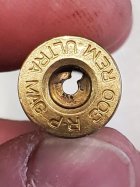Yeah, and that’s still not enough PSI to do what this thread is about. Something is missing from the story.23,000 PSI Est. https://discover.dtic.mil/
You are using an out of date browser. It may not display this or other websites correctly.
You should upgrade or use an alternative browser.
You should upgrade or use an alternative browser.
Squib load...bullet stuck
- Thread starter oneriver
- Start date
Correct. So what happened to all the pressure from the primer in my test? One shot barely moved the bullet, the other one shoved it in the rifling .5 inches.Yes, but that's with an open flash hole, correct?
OP stated the brass had no flash hole.
DShortt
Gold $$ Contributor
The primer alone doesn't create enough volume/pressure to even unseat the bullet in one case, just lodged it in the leade in the second case.Correct. So what happened to all the pressure from the primer in my test? One shot barely moved the bullet, the other one shoved it in the rifling .5 inches.
Not sure what you expected?
I still believe what the OP experienced was the result of a significantly reduced charge and the powder combusted erratically. Some powders do not behave well in significantly reduced loads. I think the primer hole was/is actually there, it's just full of powder residue that only partially combusted.
There's a disputed but documented scenario called Secondary Explosion Effect (SEE). I am not versed well enough to attempt to defend or refute this. On occasion things are seen which do make me believe that there is validity to it.
What I took from it is loadings below minimal charges with slower powders is not something I am interested in experimenting with.
Last edited:
I expected pretty much what happened in my test. Please read the rest of my posts.The primer alone doesn't create enough volume/pressure to even unseat the bullet in one case, just lodged it in the leade in the second case.
Not sure what you expected?
I still believe what the OP experienced was the result of a significantly reduced charge and the powder combusted erratically. Some powders do not behave well in significantly reduced loads. I think the primer hole was/is actually there, it's just full of powder residue that only partially combusted.
There's a disputed but documented scenario called Secondary Explosion Effect (SEE). I am not versed well enough to attempt to defend or refute this. On occasion things are seen which do make me believe that there is validity to it.
What I took from it is loadings below minimal charges with slower powders is not something I am interested in experimenting with.
Similar threads
- Replies
- 88
- Views
- 14,472
Upgrades & Donations
This Forum's expenses are primarily paid by member contributions. You can upgrade your Forum membership in seconds. Gold and Silver members get unlimited FREE classifieds for one year. Gold members can upload custom avatars.

Click Upgrade Membership Button ABOVE to get Gold or Silver Status.
You can also donate any amount, large or small, with the button below. Include your Forum Name in the PayPal Notes field.
To DONATE by CHECK, or make a recurring donation, CLICK HERE to learn how.

Click Upgrade Membership Button ABOVE to get Gold or Silver Status.
You can also donate any amount, large or small, with the button below. Include your Forum Name in the PayPal Notes field.
To DONATE by CHECK, or make a recurring donation, CLICK HERE to learn how.











